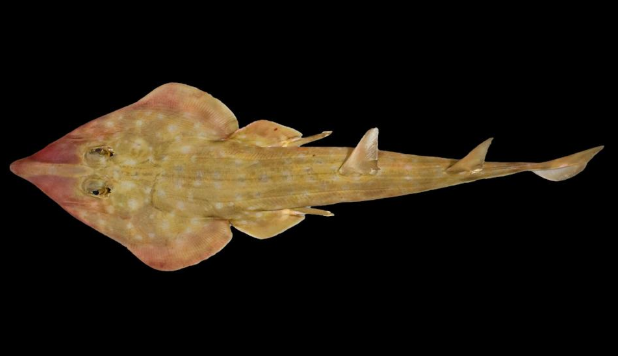
Roughly every 13 years, a new species is discovered in the ocean. This year, March 2025, the Ocean Census discovered over 800 new species in our ocean. The expedition launched two years ago in April 2023, aiming to discover 100,000 new species within the first decade. Two years later, they have discovered 866. Among those 866 species, a new species of Rhina ancylostoma, or better known as a “Guitar Shark,” was discovered.
Discovered by David Ebert on the coast of Mozambique, the new unnamed guitar shark is actually not a shark at all; in fact, it is a species of ray with a noticeable triangular nose shape and sets of dorsal fins that can easily be mistaken for a shark. Unlike most species of rays, this does not have a protective stinger or sets of sharp teeth that would make it more similar to a shark. Instead, this species uses stealth and camouflage to defend itself, and contains rows of flat teeth to help aid its consumption of crustaceans. Some species of guitar shark, such as the bowmouth guitar shark, have spikes on the back of their spines to help protect them from predators.
The first species of guitar shark was discovered in 1801 by Marcus Elieser Bloch and Johann Gottlob Schneider. Around 224 years later, there have only been 38 species of guitar shark discovered, including the most recent. Discovering a new marine animal or species takes immense time and effort, as it only happens every 13 years, as mentioned earlier. Not only that, but it’s costly as well. Oliver Steeds mentions that the cost of discovering 100,000 marine species could cost around $1 billion. With the discovery of new species, biologists and scientists can understand our waters and ecosystems better. Guitar sharks are becoming increasingly endangered; their status as of 2025 is “critically endangered”, and they have been likened to the “pandas of the ocean” due to their population status.
Another creature among the 866 newly discovered is a predatory gastropod. Gastropods are essentially snails; the new one has been named Turridrupa magnifica and is predatory due to its venomous teeth. This snail uses its sharp teeth, which have been likened to a harpoon, to inject venom into their prey. Turridrupa magnifica was discovered by Dr. Peter Stahlschmidt in New Caledonia and Vanuatu. The discovery of this snail was made in deep waters, around 400 meters, and its discovery is currently being used for new medicinal purposes.
With the discovery of new animal species, environments, plants, or anything relating to life and nature, it can help scientists understand our planet more and how to make species such as the guitar shark endure. Not only that, but with the understanding of natural life forms (or geographical), it provides information on how these creatures and ecosystems interact with one another. Examining their interactions supplies information about our planet Earth and its history, how some ecosystems may seem harsh to animals and plants, but to others give a sustainable life according to their adaptations to their ecosystems.
Discoveries such as these not only provide information about our Earth as mentioned above, but can also lead to new modern technologies and medicines. Many modern technologies, such as airplanes and boats, have been engineered to mimic the qualities of animals such as birds and sharks. For example, sharks contain a special type of skin that prevents them from getting parasites, provides them with armor, and helps guide them to reach fast speeds in the water. The short-finned mako shark, for instance, can reach speeds of up to 46 miles per hour. By studying their skin, scientists have been able to bring those qualities to boats, allowing them to glide in the water and provide smooth sailing for both the captain and the passengers on the boat.
This is only one of many examples in technology where scientists have used traits and qualities from the animal kingdom to aid their construction, invention, and adaptation of technology and medicine. It is no surprise that a new discovery for any species of life is reason to celebrate and announce.
Conservationists are able to use data from these findings to help protect and conserve our planet. Now more than ever, life forms are becoming critically endangered and extinct due to overhunting, pollution, disease, invasive species, destruction of habitat, and more. The variety of guitar shark, which was recently discovered, is only one in 47,000 species that have been considered critically endangered. To put into perspective, animals which have been considered critically endangered have a 50% chance of going extinct within 10-30 years.
The new findings by the Ocean Census are, without a doubt, considered to be huge achievements in the conservation and animal side of news. With 866 newly discovered species, scientists can further their studies to make new technological and medicinal advancements, help conserve our planet, and spread information about Earth and how its complex systems are able to interact with one another.